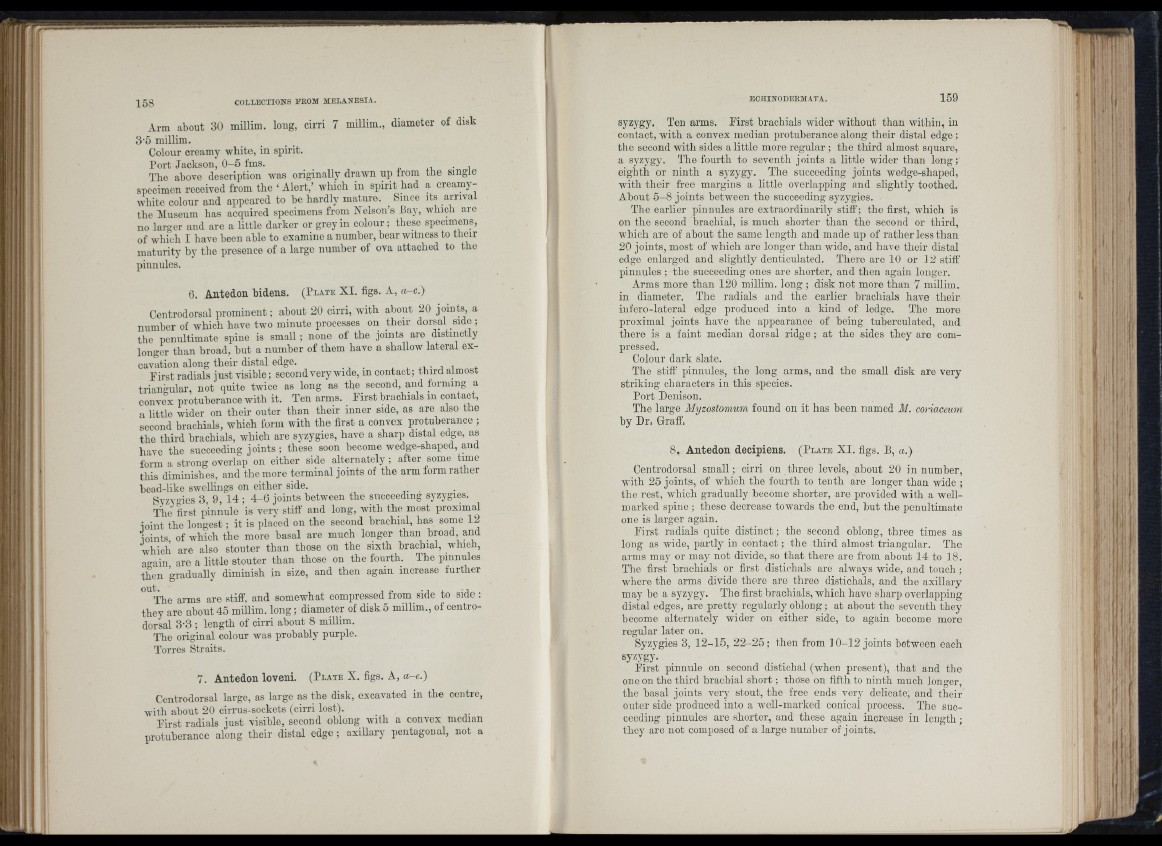
158 COLLECTIONS EROM MELANESIA.
millim. loug, cirri 7 millim.,Arm about 30 diameter of disk
3-5 millim.
Colour creamy white, in spirit.
Port Jackson, 0 -5 fms. • i
The above description was originally drawn up from the single
specimen received from the ‘ Alert,’ which iu spirit had a creamy-
wliite colour and appeared to be hardly mature. Since its arrival
the Museum has acquired specimens from Nelson’s Pay, which are
no larger and are a little darker or grey in colour; these specimens,
of wliich I have been able to examine a number, bear witness to their
maturity by the presence of a large number of ova attached to tho
pinnules.
6. Antedon bidens. (P la te XI. figs. A, a-c.)
Centrodorsal prominent; about 20 cirri, with about 20 joints, a
number of which have two minute processes on their dorsal sid e ;
the penultimate spine is sm a ll; none of the joints are distinctly
longer than broad, hut a number of them have a shallow lateral excavation
along their distal edge. ^ i J 1 4.
First radials just visible; second very wide, in contact; third almost
triani-ular, not quite twice as long as the_ second, and forming a
convex protuberance with it. Ten arms. F irst brachials in contact,
a little wider on their outer than their inner side, as are also the
second brachials, which form with the first a convex protuberance ;
the third brachials, which are syzygies, have a sharp distal edge, as
have the succeeding joints ; these soon become wedge-shaped, and
form a strong overlap on either side alternately ; after some time
this diminishes, and the more terminal joints of the arm form rather
bead-like swellings on either side.
Syzyries 3 9, 14 ; 4 -6 joints between the succeeding syzygies.
The first pinnule is very stiff and long, with the most proximal
joint the longest; it is placed on the second brachial, has some 12
mints of which the more basal are much longer than broad and
which are also stouter than those on the sixth brachial, which,
a-ain are a little stouter than those on the fourth. The pinnules
then gradually diminish in size, and then again increase further
°^The arms are stiff, and somewhat compressed from side to side :
they are about 45 millim. lo n g ; diameter of disk 5 millim., of centrodorsal
3-3 ; length of cirri about 8 millim.
The original colour was probably purple.
Torres Straits.
7. Antedon loveni. (P la te X. figs. A, a-e.)
Centrodorsal large, as large as the disk, excavated in the centre,
lyith about 20 cirrus-sockets (cirri lost).
First radials ju st visible, second oblong with a convex median
protuberance along their distal edge ; axillary pentagonal, not a
syzygy. Ten arms. First brachials wider without than within, in
contact, with a convex median protuberance along their distal edge ;
the second with sides a little more regular ; the third almost square,
a syzygy. The fourth to seventh joints a little wider than long;
eighth or ninth a syzygy. The succeeding joints wedge-shaped,
with their free margins a little overlapping and slightly toothed.
About 5 -8 joints between the succeeding syzygies.
The earlier pinnules are extraordinarily stiff; the first, which is
on the second brachial, is much shorter than the second or third,
which are of about the same length and made up of rather less than
20 joints, most of which are longer than wide, and have their distal
edgo enlarged and slightly denticulated. There are 10 or 12 stiff
pinnules ; the succeeding ones are shorter, and then again longer.
Arms more than 120 millim. loug ; disk not more than 7 millim.
in diameter. The radials and the earlier brachials have their
infcro-lateral edge produced into a kind of ledge. The more
proximal joints have the appearance of being tuberculated, and
there is a faint median dorsal ridge ; at the sides they are compressed.
Colour dark slate.
The stiff pinnules, the long arms, and the small disk are very
striking characters in this species.
Port Denison.
The large Myzostomum found on it has been named M. coriaceimi
by Dr. Graff.
8. Antedon decipiens. (P la te X I. figs. B, a.)
Centrodorsal small; cirri on three levels, about 20 in number,
with 25 joints, of which the fourth to tenth are longer than wide ;
the rest, which gradually become shorter, are provided with a well-
marked spine; these decrease towards the end, hut the penultimate
one is larger again.
First radials quite d istin c t; the second oblong, three times as
long as wide, partly in co n ta c t; the third almost triangular. The
arms may or may not divide, so th at there are from about 14 to 18.
The first brachials or first distichals are always wide, and to u ch ;
where the arms divide there are three distichals, and the axillary
may be a sj’zygy. The first brachials, which have sharp overlapping
distal edges, are pretty regularly oblong; at about the seventh they
become alternately wider on either side, to again become more
regular later on.
Syzygies 3, 12-15, 22-25 ; then from 10-12 joints between each
syzygy.
First pinnule on second distichal (when present), th at and tho
one on the third brachial sh o rt; those on fifth to ninth much longer,
the basal joints very stout, the free ends very delicate, and their
outer side produced into a well-marked conical process. The succeeding
pinnules are shorter, and these again increase in len g th ;
they arc not composed of a large number of joints.
iI H *
' I' H
I 1 /
!. ! I
■' 'I
ii 4
: H 'i
II i
i i